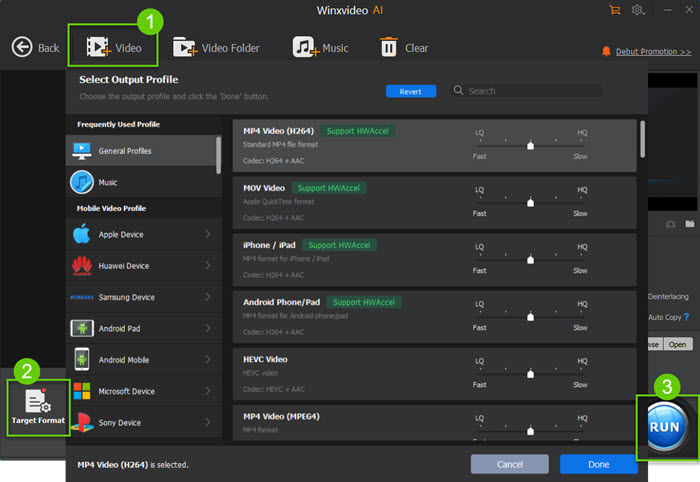[Solved] MOV Files Won’t Play, Open, Read, or Recognize
MOV is a commonly used format, however,MOV file won’t play error occurs on the most popular media players especially when playing the huge 4K Ultra HD MOV and MOV HEVC videos. QuickTime Player, VLC, iMovie, Adobe Premiere Pro, and other software won't open or import MOV footages, MOV video file playback is choppy/freezing/stuttering, audio track missing, etc. are also common issues. If you have run into the same MOV won't play problem, use below troubleshooting guide to help clarify the specific MOV video not playing issue and easily fix it.
Table of Contents:
Part 1. Possible Reasons and Solutions to MOV Videos Not Playing
Based on different situations, we explains them one by one to help you find the real reasons and corresponding solutions to your MOV video not playing issues.
Situation 1. MOV File Won’t Open and Recognize in Media Players
This is a very common issue. No matter you use QuickTime, Windows Media Player, VLC Media Player, or any other mainstream video players, you may have problems in playing MOV on Mac or Windows 10. You may encounter an error codec, a black screen, or an error message like QuickTime can’t open MOV, the file format is not supported.
Possible causes: These MOV videos are recorded by iPhone, iPad, Nikon/Canon cameras, or DJI drones, and your media player probably doesn’t support the required codec for the MOV video playback. Put more specifically, MOV is a container format which can include different kinds of codecs which possibly won’t be recognized by your media player. For example, VLC has difficulty in playing 4K MOV videos encoded with newer codec like HEVC and AV1, and Windows Media Player needs extra MOV codec for successful MOV playback. Besides, corrupted or empty MOV file cannot be opened from start to end.
Best solution: Based on the analysis, missing codec or codec incompatibility is the main reason to this type of MOV not playing error. The easiest and direct way is to convert MOV to MOV with required codec or a format like MP4 that is universally compatible with all the mainstream media players. To convert MOV to MP4 under this situation, you can use Free Video Converter to help you convert MOV and also downsize 4K to 1080p for smoother playback.
Situation 2. MOV Videos Won’t Read and Import in Video Editors
Sometimes, you may discover you can’t import MOV to Adobe Premiere, iMovie, Lightworks, HitFilm, Windows Movie Maker, Sony Vegas, DaVinci Resolve, etc. video editors for editing. It shows no video file and nothing happens, or choppy playback even you have imported the video.
Possible cause 1: Your MOV file is damaged or empty. You can check the file size of the MOV file you can’t open, if it is with only a few kb, it may refuse to process. You can also test the MOV video with other media players or video processing programs to see if it is corrupted. If they still can’t play the MOV file, the issue must be with your MOV file. You can use a video repair software to repair corrupted MOV video for further playback.
Possible cause 2: The codec inside your MOV file is not compatible with your video editor. MOV is a container format and can be encoded with different codecs that may be not accepted by your program or operating system. Many devices capture HEVC MOV footages, such as iPhone 7 or later running iOS 11 or later, DJI Phantom 4 Pro, Mavic 2 Pro/Zoom, and many more. HEVC video viewing and editing require macOS High Sierra or later. The support for HEVC codec was removed from Windows 10 Fall Creators Update. MOV HEVC video processing in Premiere Pro CC requires version 12.0.1 or later.
HitFilm currently doesn't include the ability to decode MOV HEVC footages. So, to solve this kind of issue, you can try to update your operating system, update your video editor to the latest version, install MOV codec pack on your computer, and more advisably transcode MOV to MP4 format that is widely accepted.
Possible cause 3: The media cache in your program is huge. When importing files, your program processes versions of these files for faster access. These are media cache files that store in the media cache database and cache data can slow down your workflow. To solve this, you can try to clear the media cache of the media player or video editor, and import your MOV clips again.
Best solutions to this situation:
- Repair the corrupted MOV file.
- Install MOV codec pack.
- Transcode MOV to MP4 format.
Situation 3: MOV Files Won’t Play Properly or Smoothly
Abnormal video playing is also a big headache even if you have successfully opened the MOV video file. Still, you may meet MOV no sound, MOV video audio out of sync, MOV 4K video choppy, MOV HDR washed out, etc. errors.
MOV video no sound: Some users reported they were able to play and edit .mov files but there is no sound. Video is fine, no error message pops up. This is also a typical codec incompatibility error. You can use another media player to play the MOV video file, make sure the volume and sound settings are correct, and also check the speakers and install the latest sound driver.
MOV video and audio out of sync: If the MOV video doesn’t match the audio after importing to VLC, QuickTime, Windows Media Player, Adobe Premiere Pro, or any other program, the MOV won’t play issue is because of corrupted media files, improper settings, a variable frame rate that your video processing software like Adobe Premiere Pro can't handle, to name a few.
MOV video freezing, stuttering, choppy, or lagging: MOV file playback stutters, the image lags behind the sound, particularly MOV video in high resolution (4K UHD) and mov video with HEVC codec. The problem happens in VLC, QuickTime Player, Adobe Premiere Pro, and other players and video editors. To explain and solve this, you need to know large 4K Ultra HD MOV video processing requires powerful enough CPU and hardware, and MOV video encoded with HEVC has a higher CPU requirement overhead than others.
Best solution to this situation:
- Try a more powerful MOV video player.
- Download MOV codec for your Mac or Windows 10.
- Convert HEVC codec to H.264 that is more compatible.
- Compress large 4K UHD MOV footages by changing 4K to 1080p, trimming, lowering down bit rate, etc.
- Use video processing programs with hardware acceleration.
Part 2. Still Not Working? A 100% Effective Fix for MOV Files Won't Play Error
According to the above explanation, the missing MOV codec or codec incompatibility is the main culprit to the MOV file won’t open and play error. To solve the issue once for all, you are highly suggested to convert MOV to MP4.
Winxvideo AI can solve MOV videos processing problems caused by incompatible video audio formats, high CPU usage load, damaged source videos, high frame rate, etc. With numerious codecs built in, it convert (4K UHD/1080p) MOV HEVC/ProRes videos to MP4 H.264, and other friendly formats quickly. The tool can also make it easy to repair corrupted MOV videos by trimming/cutting, adjust video audio bit rate, frame rate, compress large 4K MOV files, and more.

Step 1. Download Winxvideo AI, install and launch it on your computer.
Step 2. On the main UI, click on the "Video Converter" button to navigate to the video conversion window.
Step 3. Click the +Video button on the main UI to add your MOV file to this tool, and choose MP4 as the output format.
Step 4. Click the Browse button to choose a destination folder to save your converted file, and then hit RUN button to start converting.






















